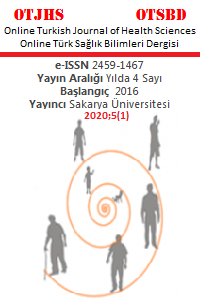Abstract
Intranasal meningocele is a
pathology that occurs as a result of herniation of the meninges in the nasal
cavity usually due to defects of the cribriform plate. They are frequently
found in the pediatric population as a result of congenital defects at the base
of the skull. Intranasal meningoceles are very rare in adults and usually occur
as a consequence of trauma. The most obvious symptoms are nasal discharge and
obstruction, making diagnosis difficult as they resemble polyps. Intranasal
meningoceles may cause serious complications unless promptly diagnosed and
treated via surgery. The most commonly used surgical procedure today is the
closure of the skull base defect through intranasal route. In our case, the
dural defect of our 59-year-old female patient with intranasal meningocele was
repaired with this technique. Postoperative 10 months follow-up showed neither
cerebrospinal fluid leakage nor other complications. We present this case with
a summary of relevant literature.
Keywords
References
- 1-David DJ. Cephaloceles classification, pathology, and management—a review. J Craniofac Surg. 1993;4(4):192-202.
- 2-Castaño-Duque CH, Monfort L, Muntané A, de Miquel MA, Pons-Irazaz. Trans-ethmoid meningocele diagnosed in adults abal LC, López-Moreno JL. Rev Neurol. 1997;25(138):230-233.
- 3-Nager GT. Cephaloceles. Laryngoscope. 1987;7(1):77-84.
- 4-Kollias SS, Ball WS, Congenital Malformation of Brain Chapter 5. In Pediatric Neuroradiology Ed. Ball WS. Lippincott; 1997:2327-2346.
- 5-Malik R, Pandya VK, Parteki S. Fronto ethmoidal meningocele. Neuroradiology. 2004;14(4):379-381.
- 6-Shetty P, Shroff MM, Sahani DV. Evaluation of high-resolution CT and MR cisternography in the diagnosis of cerebrospinal fluid fistula. Am J Neuroradiol. 1998;19633-639
- 7-İsmi O, Özcan C, Vayısoğlu Y, Koray K, Kuyucu N. Endoscopik Nazal meningocele and CSF Leak Repair using inferior Turbinate Greft. Turkish J Rhinology. 2015;4(1):34-8.
- 8-Martín C. Martínez CG, Serramito GR, Espinosa RF. Surgical challenge: endoscopic repair of cerebrospinal fluid leak. BMC Res Notes. 2012;5:459.
- 9-RandolphG. Comprehensive Techniques in CSF Leak Repair and Skull Base Reconstruction.Adv Otorhinolaryngol. 2013;(74):33-41.
- 10-Nyquist GG, Anand VK, Mehra S, Kacker A, Schwartz TH. Endoscopic endonasal repair of anterior skull base non-traumatic cerebrospinal fluid leaks, meningoceles, and encephaloceles. J Neurosurg. 2010;113(5):961-6
Abstract
Burun
içi meningosel, kribriform plakadaki defekte bağlı olarak meninkslerin burun
boşluğuna fıtıklaşması sonucunda ortaya çıkan patolojidir. Bunlar, sıklıkla
pediatrik popülasyonda kafatası tabanındaki doğuştan bir defekt nedeniyle
bulunur. Burun içi meningosel, erişkinlerde çok nadirdir ve genellikle travma
sonucu ortaya çıkar. En belirgin semptom burun akıntısı ve tıkanıklığıdır.
Poliplere benzediğinden teşhis edilmeleri zordur. Teşhis edilmediği takdirde
ciddi komplikasyonlara yol açarlar. Tedavisi cerrahi olup günümüzde kullanılan
cerrahi yöntem intranazal yolla kafa tabanı defektinin kapatılmasıdır. Elli
dokuz yaşındaki bir kadın hasta da, meningosele bağlı dural defekt,intranazal
yolla kapatıldı. Postoperatif 10 aylık takiplerinde herhangi bir beyin omurilik
sıvısı sızıntısı ya da başka bir komplikasyon bildirilmedi. Bu vaka literatür
eşliğinde sunuldu.
Keywords
References
- 1-David DJ. Cephaloceles classification, pathology, and management—a review. J Craniofac Surg. 1993;4(4):192-202.
- 2-Castaño-Duque CH, Monfort L, Muntané A, de Miquel MA, Pons-Irazaz. Trans-ethmoid meningocele diagnosed in adults abal LC, López-Moreno JL. Rev Neurol. 1997;25(138):230-233.
- 3-Nager GT. Cephaloceles. Laryngoscope. 1987;7(1):77-84.
- 4-Kollias SS, Ball WS, Congenital Malformation of Brain Chapter 5. In Pediatric Neuroradiology Ed. Ball WS. Lippincott; 1997:2327-2346.
- 5-Malik R, Pandya VK, Parteki S. Fronto ethmoidal meningocele. Neuroradiology. 2004;14(4):379-381.
- 6-Shetty P, Shroff MM, Sahani DV. Evaluation of high-resolution CT and MR cisternography in the diagnosis of cerebrospinal fluid fistula. Am J Neuroradiol. 1998;19633-639
- 7-İsmi O, Özcan C, Vayısoğlu Y, Koray K, Kuyucu N. Endoscopik Nazal meningocele and CSF Leak Repair using inferior Turbinate Greft. Turkish J Rhinology. 2015;4(1):34-8.
- 8-Martín C. Martínez CG, Serramito GR, Espinosa RF. Surgical challenge: endoscopic repair of cerebrospinal fluid leak. BMC Res Notes. 2012;5:459.
- 9-RandolphG. Comprehensive Techniques in CSF Leak Repair and Skull Base Reconstruction.Adv Otorhinolaryngol. 2013;(74):33-41.
- 10-Nyquist GG, Anand VK, Mehra S, Kacker A, Schwartz TH. Endoscopic endonasal repair of anterior skull base non-traumatic cerebrospinal fluid leaks, meningoceles, and encephaloceles. J Neurosurg. 2010;113(5):961-6
Details
| Primary Language | English |
|---|---|
| Subjects | Health Care Administration |
| Journal Section | Case report |
| Authors | |
| Publication Date | March 31, 2020 |
| Submission Date | February 7, 2019 |
| Acceptance Date | June 21, 2019 |
| Published in Issue | Year 2020 Volume: 5 Issue: 1 |


